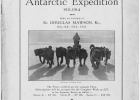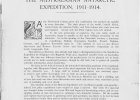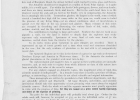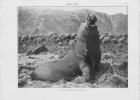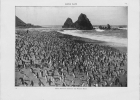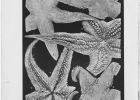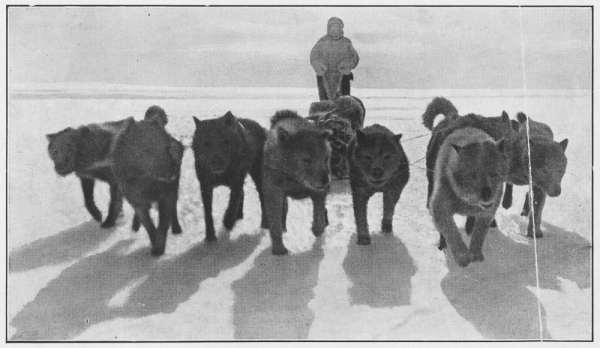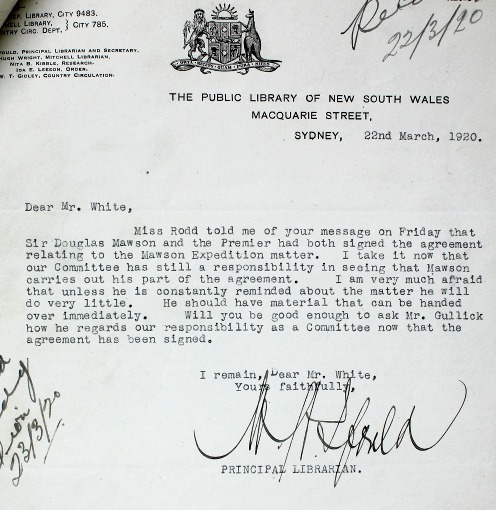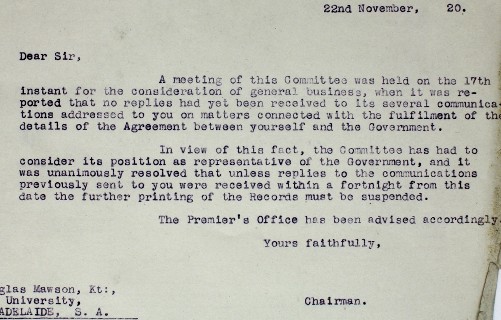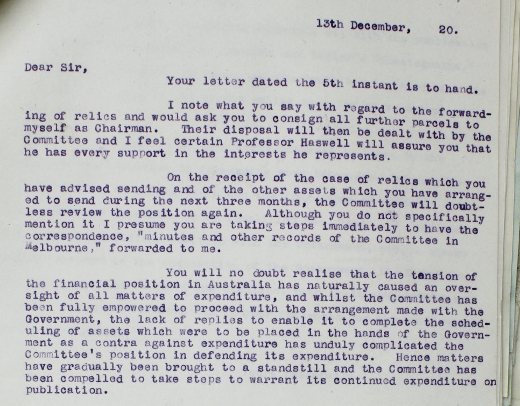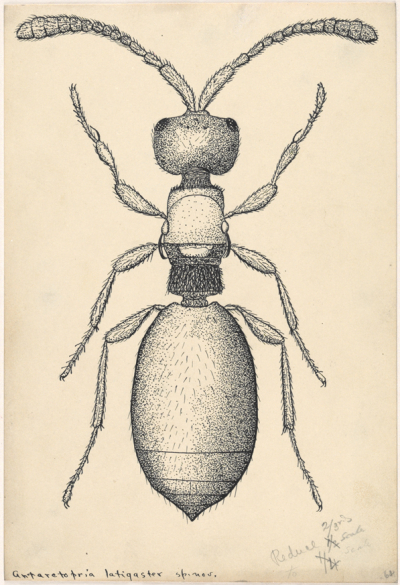Publishing the records of his Australasian-Antarctic Expedition, 1911-14
The Australasian Antarctic Expedition 1911-14 provided the world with more than a truly heroic tale of survival against the odds. It left the legacy of a vast collection of valuable scientific data and specimens in the areas of geology, cartology, biology, meteorology and geo magnetism.
Publishing the Expedition
In 1920 Sir Douglas Mawson entered into an agreement with the New South Wales State Government to publish these records. The project was not completed until 1947 – 28 years after the initial agreement was signed and 33 years after Mawson’s return.
To celebrate this historic milestone of exploration and scientific endeavour we are shining a spotlight on the somewhat heroic efforts of both Sir Douglas Mawson and the committee in charge of the printing of the voluminous scientific reports resulting from this groundbreaking expedition.
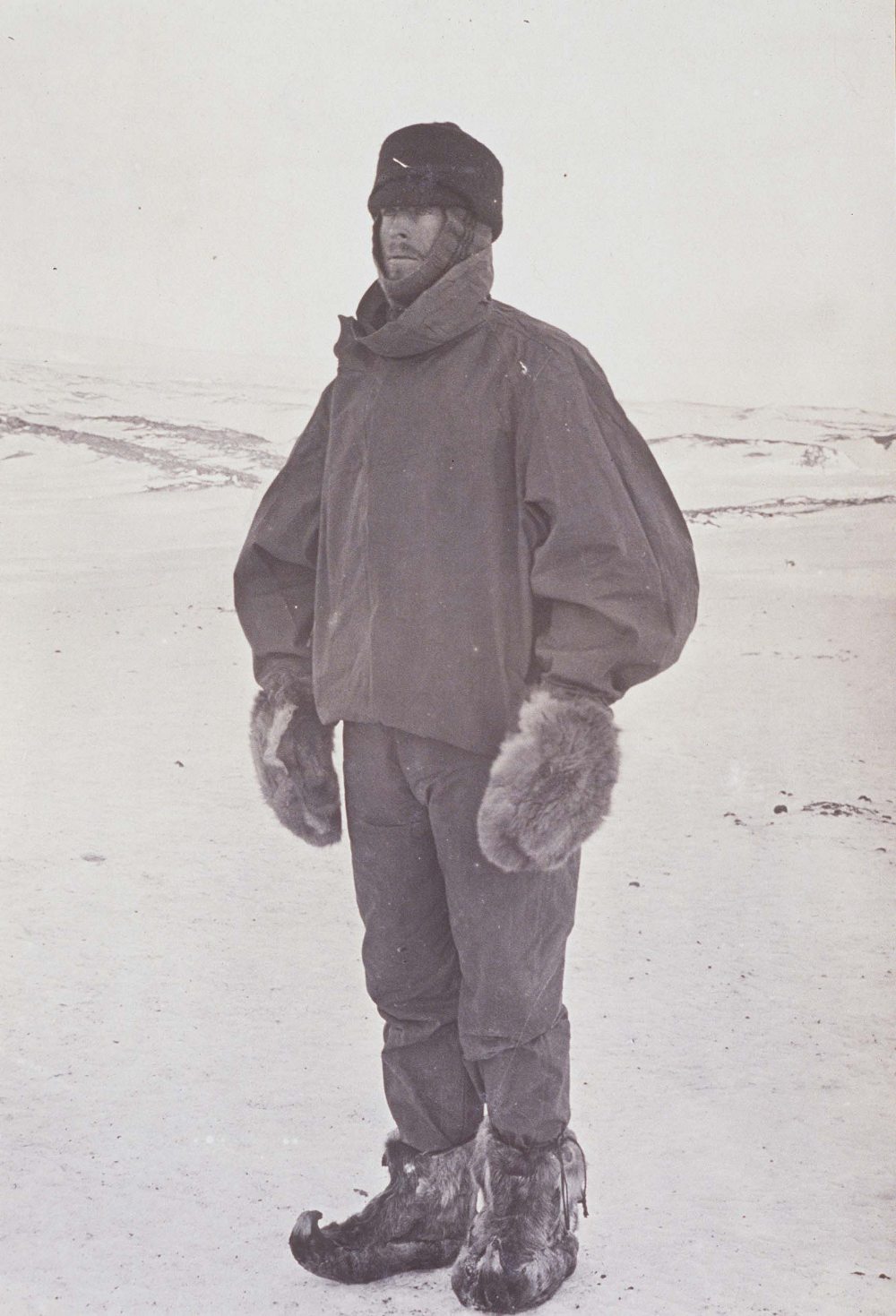
Douglas Mawson at Cape Royds 1909 – Photographer unknown – Courtesy Australian Antarctic Division
Questions for the curious
Q: Why did it take more than a quarter of a century to publish these records?
Q: What is an Antarctopria latigaster?
Q: Which ingenious method of transport did Mawson devise using a few pocket tools and the case of a theodolite?
Q: Were the members of the Australasian Antarctic Expedition in fact some of the pioneer models for British fashion houses Burberry and Jaeger?
You will find answers to all these questions and more in this gallery based upon material from our collection.
The Australasian Antarctic Expedition (AAE) 1911-14
The Australasian Antarctic Expedition, led by the then Dr Douglas Mawson, departed Hobart on the Aurora on Saturday 2nd December 1911. Bases were established at Commonwealth Bay, the Shackleton Ice Shelf and Macquarie Island. Extensive scientific and meteorological observations were made at all three bases and, in addition, a comprehensive programme of marine studies was carried on board the Aurora. The expedition, though undertaken primarily for the purpose of scientific enquiry, was to become all the more memorable for Mawson’s heroic tale of survival as he struggled 150km back to base camp following the deaths of his colleagues Lieutenant B.E.S. Ninnis and Dr Xavier Mertz.
Mawson, himself seriously debilitated, discarded everything that was not essential for survival, except his geological specimens and records of the journey
(ADB Vol. 10)
It was this total commitment to the survival of the records that later enabled Mawson, as part of an international team of scientists, to transform this raw data into an enduring legacy. The process lasted more than three decades and took place against the backdrop of two World Wars and the Great Depression.
Published by the New South Wales Government Printer the “Scientific reports of the Australasian Antarctic Expedition 1911-14” were truly groundbreaking. However, the long road to completion and publication was very rocky and it is this journey upon which we are going to focus.
Mawson decided to place much reliance on dogs for transport. Much debate arose regarding the use of dogs. Amundsen got to the South Pole and returned with dogs whilst Scott didn’t use dogs and didn’t return. Mawson used dogs and nearly didn’t return, but the dogs provided most of the food supply for the return journey and Mertz probably died from eating dog liver.
David Taylor. Douglas Mawson: Gathered with sweat and aching bones. in 100 years of Australian Scientific Explorations. Peter Stanbury (ed). Holt, Rinehart and Winston. Sydney 1975.
Fighting for Finances
Mawson had originally planned to fund the publication of the Scientific Reports from the proceeds of his own account of the expedition Home of the Blizzard (published 1915), the film made by Frank Hurley, the AAEs official photographer and from his own public lecture tours. Mawson’s high public profile, boosted still further by his knighthood in 1914, would surely have added to the prestige and commercial value of these ventures.
The outbreak of the First World War prompted a dramatic reversal of fortune. Commercial interest in the enterprise waned as did available financial assistance from both the government and private sponsors. Mawson’s time was also divided after his attachment to the British Ministry of Munitions in 1916 (ADB Vol.10). The deaths of several expedition colleagues during the war, namely Leslie Blake (cartographer and geologist), Lt Robert Bage (astronomer) and Charles Harrison (biologist) affected Mawson not only personally but professionally in terms of the vital expertise lost. By 1916, when Mawson first applied to the New South Wales State Government for assistance, he had already farmed out expedition material to more than eighty international scientists to prepare, without charge, for publication. This was testament to both his diplomacy and organizational skills. However it was also an ominous indication of the vast scale of the work at hand.
Extract of letter from Sir Douglas Mawson to the Premier of NSW W.A.Holman requesting assistance in the publishing of the records of the Australasian Antarctic Expedition, 23 January 1916. NRS 3830 [20-12847 pt]
The letter states his case to obtain funding and the services of the NSW Government printers Office to publish the full scientific reports of the AAE.
Letter from Sir Douglas Mawson to the NSW Premier requesting government assistance to publish the scientific records of the Australasian Antarctic Expedition, 24 January 1916. NRS 3830 [20-12847 pt]
24 January 1916
Dear Mr Holman,
When I called
at the Treasury as few days
ago hoping to meet you it
was with the object of requesting
some assistance, through the
Government Printing office, in the publication of the Scientific
Results of the Australasian
Antarctic Expedition. I was
sorry to find you overrun
with work, but trust that
your health will be benefitted
by the proposed visits to Tasmania. My request can
2
be made in writing just as well.
Today I am forwarding under
separate cover a statement of
the case. I have had a chat with
Mr Gullick, the Government Printer,
and apparently he welcomes the
prospect of the work for such
gives the opportunity of showing
to the World with what perfection
the work is done at the Sydney
Printing Office, I have no
hesitation in stating that
nowhere in the World can better
work of its kind be done than
at the Government Printing Office
in Sydney.
It would have been particularly
nice to have had the whole
of the Scientific Publications of
3
the Expedition published at the
Sydney office but it would
have been asking rather a lot,
and in much bulk would be
apt to interfere with the regular
work.
I hope that you received safely
some months ago an autographed
copy of “The Home of the Blizzard”.
Mr T Ryan, MP of Adelaide,
at that time visiting Sydney
offered to deliver it personally,
but I never heard whether you
got the volumes. You have
been so much engaged that
doubtless you will have forgotten.
I am leaving for Melbourne in a couple of hour’s time
4
but will again visit Sydney
shortly. In the meantime I
will be glad to hear what
you decide re assisting the
publication – and trust that
it will receive your fullest sympathy.
Yours very truly
Douglas Mawson
Handwritten official offer from Sir Douglas Mawson to the NSW Government of the records of the Australasian Antarctic Expedition in exchange for the printing of the scientific reports, 6 June 1919
Dear Mr Hay Herewith is my
official offer to the N.S.W.
Govt. amplifying my notes
and verbal statement placed
before the Premier last week.
I do hope that N.S.W.
will see this through, and
am certain that the collections
will prove a great asset in future.
My address for some time
henceforth will be The University
Adelaide
Yours truly Douglas Mawson
In March 1920 an Agreement was entered into between Sir Douglas Mawson and the New South Wales Government for the printing of the records of the Australasian Antarctic Expedition. In 1919 the Committee on Printing of Records of Australasian Antarctic Expedition was formed to oversee the process. The founding Chairman was William Gullick, Government Printer, and the founding members were William Ifould, Principal Librarian, Public Library of New South Wales and Charles Hedley, Acting Curator, Australian Museum. Under the terms of the Agreement, the expedition assets would be handed over to the State of New South Wales in return for the printing of the Scientific Reports of the Australasian Antarctic Expedition. The cost was not to exceed £5000 and was to be spread over a period of five years.
These conditions were to prove well nigh impossible to fulfill…
Minutes of the meeting held on 19 June 1919
The minutes of this meeting highlight the suggestions proposed by the Committee in response to Mawson’s letter setting out the terms of his offer. NRS 19745
The agreement between Sir Douglas Mawson and the NSW Government
In March 1920 an agreement was entered into between Sir Douglas Mawson and the New South Wales Government providing for the printing of the records of the Australasian Antarctic Expedition. The basis of the agreement was that the assets of the expedition be handed over to the State of New South Wales in return for the State undertaking the printing of the records at a cost not to exceed £5,000 spread over a period of 5 years.
Page 4 of the agreement provides a listing of the main categories of official records of the AAE Expedition. The wireless logs and manuscripts of messages are records of the first radio transmissions in the Antarctic. The young Frank Hurley’s photographs of the expedition provided a strikingly brilliant visual record of the team members at work and of the incredible antarctic landscape. These, along with Hurley’s iconic WW1 photographs are held by the Mitchell Library in Sydney. NRS 3830 [20-12847 pt]
A Shaky Start 1920-24
I take it now that our Committee has still a responsibility in seeing that Mawson carries out his part of the agreement. I am very much afraid that unless he is constantly reminded about the matter he will do very little.
W.H. Ifould, Principal Librarian to A.J.White, Secretary of the Committee 22nd March 1920 (three weeks after the Agreement was signed).
NRS 12169 [2/994]
By November 1920, eight months after the Agreement had been signed, the concerns of the Printing Committee were expressed with far greater force. Citing lack of communication and delivery of expedition assets on Mawson’s part, the Committee threatened to suspend publication of the Reports. Potential disaster was averted via Mawson’s apologetic communication, the conciliatory tone adopted by the Committee Chairman and possibly, most importantly, the arrival of a collection of significant expedition relics.
The explanatory notes provided with the relics highlight the often dire conditions faced by members of the Australasian Antarctic Expedition.
Devoid of all crampon equipment and wearing only finnesko Dr. Mawson found himself at the end of that journey faced with the descent of steep ice slopes with a raging wind behind. It was impossible to stand up in naked finnesko and this grip was contrived for the soles employing a few pocket tools and the case of the theodolite.
NRS 3830 [2/994]
Letter from W.H. Ifould to A.J. White stating concerns regarding Sir Douglas Mawson’s reliability, 22 March 1920
Letter to Sir Douglas Mawson from the Chairman of the Committee threatening to suspend publication process, 22 November 1920. NRS 12169 [2-994]
Letter from Sir Douglas Mawson to Mr Gullick (in reply to the above letter) addressing claims the conditions of the agreement with the NSW Government were not being met, 5 December 1920. NRS 12169 [2-994]
Dear Mr Gullick,
Your letter of
22nd November to hand,
intimating that printing will
be suspended unless replies
to your earlier letters regarding
handing over of Expedition trophies
are received – I have to
state that so far as I am
aware letters on this subject
from you have been answered.
It is possible that a letter
may have got side tracked
for there has been an unprecedented
upheaval here amongst my affairs
owing to the entire reorganisation
and reestablishment of the
Geological Dept. at this University
2
and also I have moved into
a new house – and proceeded
with the unpacking of numerous
boxes packed in London during
my sojourn there. All this has
tended to great disorganisation.
I am only too ready to cooperate
with you and indeed am greatly
indebted to the printing committee
its efforts on behalf of the
Expedition results.
For some time past I have been
busy packing up the relics
indicated in the document
mutually signed by the N.S.W.
Govt. and myself. A large
case measuring 3 1/2 tons cubic
capacity has gone forward
c/o Graves, Hill & Co (carriers) and
is addressed to the Mitchell
Library for I understand
that such relics are to be
kept there. The contents
3
includes sledges, tents, clothing
etc as itemised from
1 to 90 with several
omissions where material has
not been immediately procurable.
In addition to the list agreed
upon I have included 15
additional relics.
All others will be cased
and sent forward from time
to time.
Should it be desirable to send the
case now on its way to any other
destination I will be glad to
change my instructions upon
hearing from you.
A complete list of the items
enclosed with short descriptions
is now being typed and will
doubtless be posted tomorrow.
4
Considerable contributions of the
general collections should reach
you during the next three
months.
I know I have been remiss
in not sending you detailed
addresses of the persons listed on
the sheet of recipients – but
I will do so as quickly as possible.
I trust that I have not
put you to very great trouble
and at same time render my
apologies. During the next
few days I will go through
all my correspondence and
put things in order if letters
have been overlooked.
Yours Sincerely
D. Mawson
Letter from W.H. Ifould, Principal Librarian, Public Library of New South Wales to W. A. Gullick, Chairman of the Committee re response to Sir Douglas Mawson, 10 December 1920
This letter gives a clear indication of very early unease within the Committee concerning the level of Mawson’s commitment to the Agreement. NRS 12169 [2/994]
Letter from the Chairman of the committee to Sir Douglas Mawson acknowledging his reply and outlining more fully the concerns of the Committee, 13 December 1920
This letter gives a concise outline of the difficulties faced by the Committee as they attempt to fulfill the requirements of both parties – the NSW Government and Sir Douglas Mawson. NRS 12169 [2-994]
List of articles taken from the case of Mawson’s relics, 20 December 1921
With the intial hiccups smoothed over, the publishing of the Scientific Reports proceeded at a somewhat stately but steady pace. By 1924 a prospectus had been published and subscriptions received from museums, universities and scientific bodies around the world.
The Prospectus
The Prospectus outlines the content of the records and the cost of each volume or a subscription to receive all records of the expedition. NRS 19745 [2-995]
A melodramatic middle 1925-31
As 1925 ( the agreed completion date of publication) came and went all was far from well. The number of completed reports and assets received by the Printing Committee had slowed considerably. This was due in part to the vast scope of the project at hand. The accumulated data was massive and covered an exhaustive number of areas of the physical and biological sciences. Along with the expedition material for which Mawson was personally responsible, he had also, of necessity, distributed material for analysis and research to eminent scientists and institutions worldwide.
A 1928 letter from Mawson to the Chairman of the Printing Committee concerning the international distribution of sections of the zoological collections from the Australasian Antarctic Expedition provides an insight into the sheer complexity of Mawson’s task.
Letter from Sir Douglas Mawson to A.J. Kent, Chairman of the Printing Committee listing the institutions and experts compiling the zoological reports of the Australasian Antarctic Expedition, 7 November 1928
This is a 3 page extract of a 5 page letter which highlights the sheer complexity and scope of Mawson’s task. Not only did he have to locate and negotiate with approximately 80 scientific experts around the globe but he also needed to keep track of their progress and pass the work on to a successor in the case of death or illness. Juggling this with his own report writing and extremely active professional obligations was a challenge of Herculean proportions. NRS 19745.
Not only did Mawson have to locate suitable scientists, but he had to keep track of their progress and encourage or badger them when necessary to forward the material for publishing. He also had to arrange for another qualified scientist to take over the preparation of a report in the event of the illness or death of one of the contributors.
Organising and maintining a steady output of material for the publishers under these circumstances ( there were all in all 95 individual contributors to the Scientific Reports) would have been challenge enough without the additional obligations of Mawson’s academic career at the University of Adelaide and his upcoming role of leader of the British, Australian and New Zealand Antarctic Expedition (1929-31).
The Printing Committee, no doubt working under severe time and financial constraints, was largely concerned with Mawson’s lack of compliance regarding the passing of assets to the New South Wales State Government, as laid out in the terms of the 1920 Agreement. Mawson, on the other hand, was far more focussed on the value of the scientific knowledge obtained from the raw data, not on the length of time this work would take to complete.
The value of the manuscripts and the trophies of the late expedition is mainly in the knowledge that will come out of their examination and description….It would be the height of folly if the New South Wales Government were at this stage to take out of my hands these collections and manuscripts. If they are taken from me, their value will forever be heavily discounted, for nobody can tell the story as I can.
Letter from Sir Douglas Mawson to the Chairman of the Committee dated 23 September 1929. NRS 12169 [2/995]
The Committee was also worried that Mawson might not return from his latest expedition to the Antarctic, thus leaving many of the assets of the Australasian Antarctic Expedition in undisclosed locations. Mawson moved to allay its fears in this regard by providing details of his arrangements in this matter.
Should anything untoward happen to me, you will know where all the items relating to the last expedition are stored. A statement to this effect is enclosed with this letter….My wife has power of attorney for me, and can carry out any of my obligations
Letter from Douglas Mawson to the Chairman of the Committee dated 23 September 1929. NRS 12169 [2/995]
Letter from Sir Douglas Mawson to A.J. Kent, Committee Chairman addressing the reasons for delays in the preparation of Expedition records, 23 September 1929
This three page letter from Sir Douglas Mawson to the Committee Chairmanwas sent prior to Mawson’s departure for the Antarctic with the British Australian and New Zealand Antarctic Research Expedition 1929-31. Mawson stresses the value of scientific specimens comes largely from the knowledge obtained through the study and description of the specimens rather than their value as mere objects in a museum. NRS 12169 [2-995]
Sir Douglas Mawson’s Inventory of the assets of the Australasian Antarctic Expedition, 24 September 1929. NRS 12169 [2-995]
This is a 4 page inventory of the AAE Expedition assets as recorded by Sir Douglas Mawson prior to his departure on the British Australian and New Zealand Antarctic Research Expedition of 1929-31. The inventory illustrates the sheer diversity of the records. On a practical level it was compiled to provide the committee with the exact location of the records should Mawson not return from what was his third major expedition to Antarctica.
Fortunately, for all concerned, Mawson did return from the British Australian and New Zealand Antarctic ResearchExpedition. Unfortunately, by September 1931 his relationship with the Printing Committee had deteriorated to the point that he was informed, not personally, but by newspaper report:
The Minister for Education (Mr Davies) announced yesterday that the Government had decided that no further public money could be spent of printing of the Australian Antarctic Expedition of 1911 to 1914…….The Government was seeking legal opinion on the possibility of recovering from Sir Douglas Mawson certain assets of the expedition.
The Sydney Morning Herald, 26th September 1931, p.13
Letter from Sir Douglas Mawson to W. Davies, Minister for Education concerning the Government’s decision to cease the publishing of the AAE Reports. Dated 5 October 1931
A two page letter from Sir Douglas Mawson to the Minister of Education regarding the cessation of printing of the AAE Reports. Mawson was justifiably incensed at not having been personally informed of the decision. He clearly states his case that the Government Printer had ignored numerous manuscripts that had been prepared and awaiting publication. (1 of 2). NRS 12169 [2-995]
The Last Leg 1932-48
In 1932, the year after the publication fo the Scientific Reports was suspended, Mawson wrote to the Minister for Education, D.H. Drummond with the aim of reigniting government interest in the project. Enclosed were extracts from J. Gordon Hayes’ book Antarctica (published 1928) that summed up the outstanding achievements of the Australasian Antarctic Expedition.
Its excellence lay in its design, its scope and its executive success: and it owes its exalted position among other Antarctic expeditions mainly to the fact that it was originated and conducted by scientists of administrative ability, who are the fit and proper persons for such undertakings.
Extract from Antarctica by J. Gordon Hayes
In the same letter Mawson puts forward the argument that scientific reports of expeditions routinely took decades to publish.
I may also add for your information that it took well over 20 years to complete the publications of the “Challenger” Expedition, notwithstanding the fact that they had at their disposal almost unlimited funds. It is only recently that the final number has appeared of the less extensive series of reports of the Scott Expedition, which preceded our own and which was also favoured with an abundance of funds. The last of the reports of Amundsen’s”Gjoa” expedition has only recently appeared, some 25 years after the work was undertaken.
Letter from Douglas Mawson to D.H. Drummond dated 12th August 1932. NRS 3842 [2/1957]
Letter from Sir Douglas Mawson to D.H. Drummond outlining the outstanding success of the AAE and the lengthy period it takes to publish the records of any major scientific expedition. Dated 12 August 1932. NRS 3842 [2-1957]
The printing of the Scientific Reports of the Australasian Antarctic Expedition was resumed in 1937 under an agreement whereby the Commonwealth Government would contribute £2850 and the New South Wales Government would provide and additional £2000 to ensure the completion of the project.
Sir Douglas Mawson’s request for Federal Government assistance to complete the publication of the AAE records. Dated 8 February 1937. NRS 3842 [2-1957]
View typescript version of the letter
Mawson wrote to W.H. Ifould, Principal Librarian, Public Library Sydney in February 1937, stressing the vital importance of the printing of the biological reports before they could be superseded by similar reports of later expeditions, thus lessening their value considerably.
Letter from Sir Douglas Mawson to W. H. Ifould, Principal Librarian, Public Library Sydney explaining how the delay in printing was risking the scientific and financila value of the Expedition’s records. Dated 19 February 1937. NRS 12169 [2-994]
The Antarctopria Latigaster of Macquarie Island. NRS 19745
A wasp from the family Diapriidae that lays its eggs in the pupae of flies. The wasp eggs hatch and the wasp larva develops inside the fly pupa
Very little correspondence appears to have been entered into between Mawson and the Printing Committee during the period of the Second World War (1939-45) as, once again, more urgent matters no doubt took priority. A report from the Committee to the Department of Education, dated 28th July 1948, signified the conclusion of the printing process. Although several manuscripts, photographs and other assets were still to be received from Mawson, and the Committee were not entirely happy with this state of affairs, it was generally agreed that the conditions of the Agreement made between Sir Douglas Mawson and the New South Wales Government twenty eight years earlier had been fulfilled.
Committee’s summary of the significant stages of the publishing of the AAE records 1919-1948. Dated 28 July 1948. NRS 3842 [2-1957]
It is interesting to note that the Committee’s worries that Mawson would not survive to see the preparation and printing of the Scientific Reports were proved groundless – Sir Douglas Mawson was in fact the one constant character in a story that commenced with his return from the Australasian Antarctic Expedition in 1914 and spread itself over two World Wars and the Great Depression.
The original Committee consisted of Messrs W.A. Gullick, Chairman, Government Printer, W.H. Ifould, Principal Librarian, C. Hedley, Acting Curator, Australian Museum.
The Committee, through death and other causes has changed in personnel and now consists of Messrs. T.H. Tennant, chairman, Government Printer, J.W. Metcalfe, Principal Librarian, E.A. Briggs, D. Sc., Sydney University.
Letter from the Committee to the Department of Education dated 28th July 1948. NRS 3842 [2/1957].
As to the Scientific Reports, they remain as a lasting testament to Sir Douglas Mawson and the members of the Australasian Antarctic Expedition, as well as to the generations of eminent scientists who laboured on the analysis and preparation of the raw scientific data and specimens.
Records used in this Gallery
- NRS 3830, Education Subject files, 1879-1984. Antarctic records, 1916-32 [20/12847 (pt)]
- NRS 12169, Premier’s Department: Committee on printing of the records of the Australian Antarctic Expedition, 1911-14: Records of the Secretary, 1917-47 [2/994-995]
- NRS 3842, Education Department: correspondence concerning the publication of the scientific reports of the Australian Antarctic expedition, 1911-14; 1932-54 [2/1957]
- NRS 19745, Government Printing Office: Papers from the committee for the printing of the records of the Australasian-Antarctic Expedition, 1911-14 [Items 1-29]
Seminar: Mawson and Antarctic Exploration
On 12 May 2011 to mark the 100th anniversary of Mawson’s 1911 Australian Antarctic Expedition, State Records and the Royal Australian Historical Society hosted an all-day seminar on the history of Antarctic exploration. The seminar was presented as part of Information Awareness Month, an annual event held each May, which aims to increase public awareness of the breadth of the information industry. State Records has published a selection of the papers from that seminar.
Related links
- 100 Years of Australian Antarctic Expeditions
- A courageous man of science
- Antarctica and Sir Douglas Mawson
- Australasian Antarctic Expedition
- In the Footsteps of Douglas Mawson
- Mawson Base image gallery
- Mawson’s Huts Foundation – Antarctica’s cultural heritage
- The Long Silence by Jenny Horsfield
Research by
Bridget Reilly, Archivist Public Access
